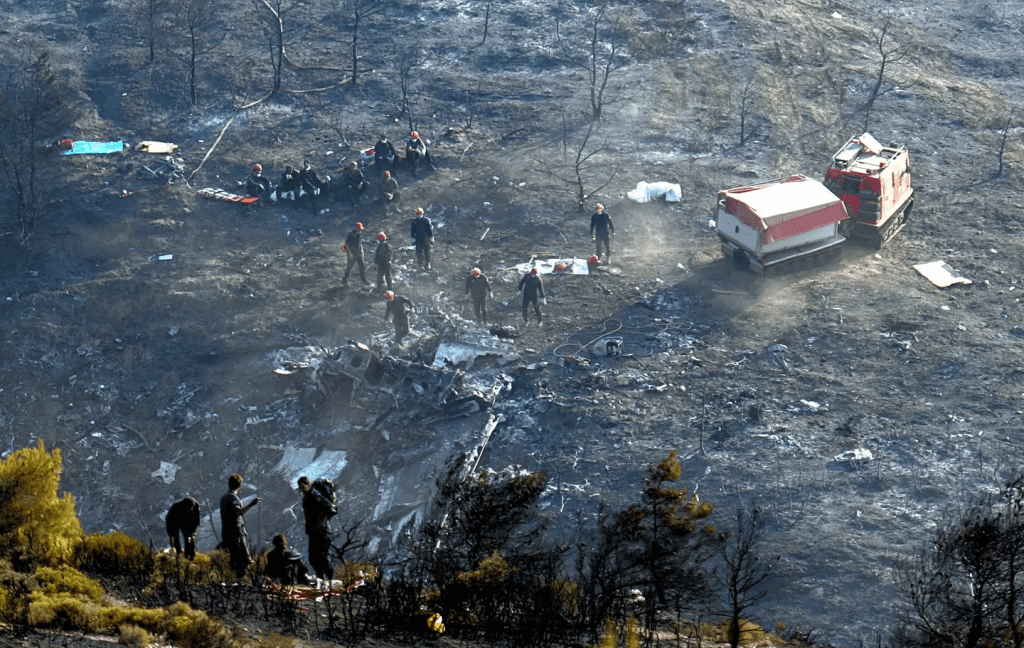On August 14, 2005, Helios Airways Flight 522, dubbed the “ghost plane,” took off on what was supposed to be a routine flight. But what unfolded in the skies over Greece remains one of the most haunting aviation disasters in history. The flight, which ended in a catastrophic crash, left all 121 people on board dead. In the aftermath, investigators uncovered a series of fatal errors that led to passengers and crew losing consciousness mid-flight, as the plane soared on autopilot for hours.
The Journey Begins: Helios Airways Flight 522

On that fateful day in August 2005, Helios Airways Flight 522 was scheduled to fly from Larnaca International Airport in Cyprus to Prague, with a stopover in Athens. The Boeing 737-300, a well-known aircraft nicknamed “Olympia,” was piloted by 58-year-old Captain Hans-Jürgen Merten and 51-year-old First Officer Pampos Charalambous. Despite their combined experience of nearly 25,000 flight hours, a small but critical oversight would soon turn the flight into a deadly disaster.
The First Sign of Trouble: Cabin Pressure Warning Ignored
Shortly after takeoff, an alarm sounded in the cockpit. The cabin altitude warning horn, designed to alert the crew to issues with cabin pressure, had activated. Unfortunately, the crew mistakenly believed the alarm to be the takeoff configuration warning, which shares an identical sound. This critical error led the pilots to disregard the warning and continue their ascent.
As the plane climbed higher, the cabin began to lose pressure, but the crew was unaware of the slow oxygen depletion occurring inside. Seven minutes into the flight, they reported an issue with the air conditioning system to the airline’s operations center. However, the real problem—loss of cabin pressure—went unnoticed, and the oxygen levels continued to drop.
Hypoxia Takes Over: A Silent Threat
By the time the aircraft reached 18,000 feet, the situation became dire. The oxygen masks deployed in the cabin, but the effects of hypoxia—a lack of oxygen—had already begun to impair the flight crew. Hypoxia is especially dangerous because it causes confusion, disorientation, and, ultimately, unconsciousness. By the time the plane leveled off at 34,000 feet, well above the safe oxygen threshold, both the captain and first officer had lost consciousness, leaving the aircraft to circle on autopilot.
Meanwhile, in the passenger cabin, the scene was equally grim. Passengers had likely donned their oxygen masks, but with the cabin still depressurizing, their supply was limited. Most, if not all, quickly lost consciousness, as the aircraft soared aimlessly through the skies.
The Ghost Plane: F-16 Fighter Jets Scramble for Answers
After an hour without any communication from the flight, Greek air traffic controllers grew concerned. In response, two Greek F-16 fighter jets were scrambled to investigate the silent aircraft, which was now circling at 35,000 feet. When the fighter pilots approached the Boeing 737, they were met with an eerie sight.
Through the cockpit windows, they saw the captain’s seat empty, and the first officer slumped over the controls, unconscious. Inside the cabin, oxygen masks hung from the ceiling, but no one moved. The plane had become a ghostly shell, flying on autopilot with no one at the helm.
A Heroic Attempt: The Last Conscious Passenger
Amid the tragedy, one person onboard remained conscious—flight attendant Andreas Prodromou. Using a portable oxygen supply, Prodromou made his way to the cockpit in a desperate attempt to save the flight. Despite holding a UK Commercial Pilot License, he was not certified to fly a Boeing 737. Nevertheless, his courage was undeniable.

Prodromou managed to briefly communicate with the fighter pilots, waving to them through the window as he attempted to regain control of the plane. But his efforts were in vain. By this point, the left engine had failed due to fuel depletion, and Prodromou’s attempts to steer the aircraft away from populated areas were limited.
The Final Moments: A Fatal Crash
Ten minutes after the left engine failed, the right engine also gave out, and the powerless aircraft began its final descent. The Boeing 737-300 crashed into a mountainous area near Grammatiko, just 25 miles from Athens. The resulting fireball destroyed much of the aircraft, leaving the bodies of many passengers burned beyond recognition.
Tragically, autopsy reports later revealed that many passengers were still alive at the time of impact, though unconscious from the effects of hypoxia.
A Chain of Errors: What Went Wrong
Investigations into the crash of Flight 522 uncovered a series of failures, both technical and human. The primary issue was traced back to the aircraft’s pressurization system. In the days leading up to the flight, Helios Airways had been dealing with ongoing issues related to the aircraft’s air conditioning system, which is closely tied to cabin pressurization. There had been seven separate inspections of the plane in the weeks before the crash, and crew members had reported unusual noises and even ice on the doors.

The night before the flight, engineers conducted a pressurization test and switched the system from automatic to manual. However, they failed to reset it to automatic after the test was completed. This critical oversight meant that the aircraft took off in manual mode, leaving the cabin unpressurized as the plane climbed to cruising altitude.
Even more concerning, the crew failed to catch the error during their pre-flight checks. Once the flight was airborne, the cabin pressure continued to decrease, setting the stage for the tragedy that followed.
A Preventable Disaster: Lessons Learned
The crash of Helios Airways Flight 522 remains one of the most sobering examples of how a combination of human error and technical oversight can lead to catastrophic outcomes. While the aircraft itself was mechanically sound, the failure to properly set and monitor the pressurization system proved fatal.

Since the accident, aviation authorities have implemented stricter protocols around pre-flight checks and system testing to prevent such disasters from happening again. However, the tragedy serves as a stark reminder of the importance of vigilance in aviation safety.
Conclusion: A Haunting Reminder of Aviation’s Fragility
The story of the ghost plane that flew for hours with unconscious passengers and crew is as heartbreaking as it is haunting. Flight attendant Andreas Prodromou’s brave attempt to save the flight stands as a testament to human courage in the face of overwhelming odds, even when survival seemed impossible.
Though the skies are much safer today thanks to lessons learned from tragedies like Flight 522, the memory of this flight remains a chilling reminder of aviation’s fragility and the critical role that attention to detail plays in ensuring the safety of everyone on board.


